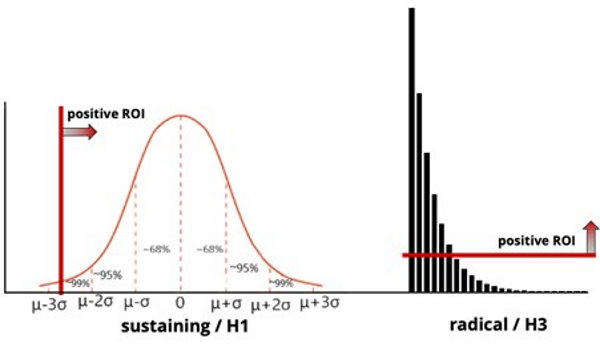
Everyone loves innovation. It communicates that things will be better. That we get more of what we want. That customers will love us more. That we’ll stand out from the crowd and be recognized for the great work we do. That the people we work with are motivated and excited. That everyone will beat a path to our door simply to throw money at us to get our innovation.
It’s pretty obvious that this is a bit of a sarcastic way to start. Few terms in business are as overloaded as “innovation.” It’s thrown around everywhere and in general means “good,” but it’s very poorly understood. In fact, I often feel it does more harm than good in conversations and banning the term would force people to say what they actually mean.
Although there are many concerns around the use of “innovation,” I want to highlight three that I think are especially important to be aware of. The first is the fundamental difference between sustaining and radical innovation. The former is concerned with adding new features to existing products, updating existing products with technology upgrades and otherwise maintaining the differentiation in already successful products. Radical innovation, on the other hand, is concerned with creating new products entirely. This is where concepts such as lean startup thinking, experimentation and fail-fast come in.
The difference between these two approaches is very significant in terms of expected return on investment. For sustaining innovation, the majority of initiatives will have a positive return and the rate of return follows a traditional Gaussian curve in terms of likelihood. The return on investment in radical innovation follows a power function. This means that the vast majority of initiatives fail to result in significant business and are shut down. However, the few that are successful generate so much new business and revenue that the investment in all the failed initiatives is paid back many times over.

The problem is that most people approach radical innovation with the sustaining innovation mindset and consequently punish the radical innovation initiatives by shutting things down after the first few initiatives that don’t pan out.
The second challenge is that most view innovation as improving the product’s capability. There are several approaches to this and in earlier posts, I’ve brought up the ten types of innovation model by Doblin (now part of Deloitte). It’s important to understand that the financial models around offerings, the processes, the channel, the business ecosystem, the service and all other product aspects are subject to innovation too and tend to have much higher returns on investment. In fact, the research shows that investment in improving product performance has by far the lowest return whereas investment in the business model and ecosystem tends to have an outsized return.
The third challenge is that many companies fail to build effective innovation systems in the organization. As I discussed here, companies need a system around innovation that includes time for employees, virtual and physical meeting places for people to exchange ideas (like hackathons), active support from senior managers (to counterbalance the resistance from the middle management layer), methods to gather customer feedback (including feedback on prototypes and MVPs) and a mechanism to get the most promising initiatives properly funded and part of the overall company resource allocation process. Many companies have one or two elements in place but fail to build flywheels that really establish a repeatable innovation machine.
The word “innovation” is thrown around all the time in industry and its meaning has basically been diluted to “good.” Unfortunately, many have a very poor understanding of the actual implications of innovation and most focus on sustaining innovations that are intended to improve the performance of already successful products. In addition, many treat innovation as either being highly predictable or completely random. Instead, our experience shows that companies need to identify that there are several types of innovation, that there’s a fundamental difference between sustaining and radical innovations and that a successful innovation culture requires an elaborate system of multiple elements to be built up. It’s not an accident but rather a repeatable innovation engine. As Simon Sinek writes, “Innovation isn’t born from the dream, innovation is born from the struggle.”
Want to read more like this? Sign up for my newsletter at jan@janbosch.com or follow me on janbosch.com/blog, LinkedIn (linkedin.com/in/janbosch), Medium or Twitter (@JanBosch).